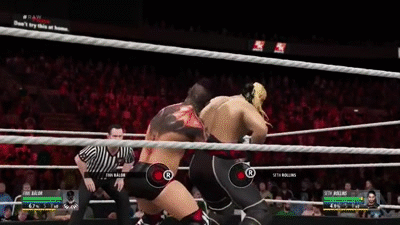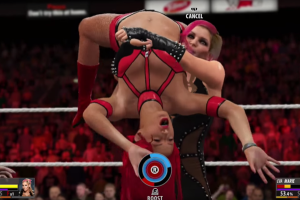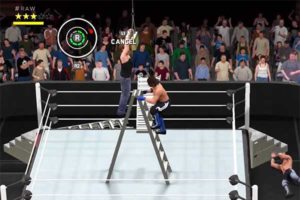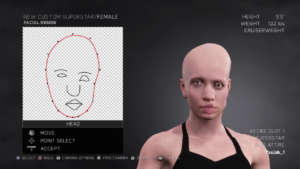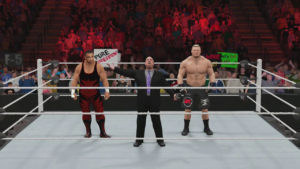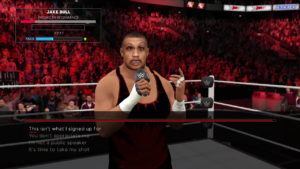2014 wasn’t a very good time for the WWE video game series. Following the releases of Microsoft’s Xbox One and Sony’s Playstation 4 consoles a year prior, “WWE 2K15” entered the world following a series of announcements both early and recent that had fans reasonably pessimistic and worried that 2K Games’ first entry in this latest generation of gaming would be disappointing. Sadly for almost everyone, the low expectations were proven valid as “WWE 2K15” came across as a beta version of what could’ve been the next enjoyable evolution in the franchise.
Thankfully for the series, its creators turned out what should’ve been its eighth generation console debut with “WWE 2K16”. Everything from its gameplay to mode offerings were more robust and satisfying than almost anything its predecessor offered – giving every WWE video game fan high hopes that the sequel would be even better. I was in the same boat as many other optimistic gamers thinking “WWE 2K17” would be one of, if not the best entries in the series.
Did I Complete “WWE 2K17”?
Sometimes it’s hard to judge what “complete” means when reviewing a wrestling game. Usually the best criteria for completion in a WWE game came courtesy of “2k Showcase” mode where the player would take one or more characters and play through a historic era of wrestling (in last year’s case the career of “Stone Cold” Steve Austin). For the first time in years the primary talking point mode has been done away with, leaving “MyCareer” mode to pick up the slack. The stand-alone mode allows a player to create his or her own wrestler (males only) and take that individual through the WWE title ranks in hopes of achieving the WWE World Heavyweight Championship or, more importantly this time around, becoming a “Paul Heyman Guy”. My time with this year’s version of “MyCareer” extended far into the double digits before my character simply achieved WWE World Heavyweight champion status. There are other things to keep a person busy (from online competition to creating your own WWE Universe), but just like last year nothing fulfills the completion quota better than “MyCareer” mode.
Did “WWE 2K17” Live Up to the Hype?
Rather than abandon what worked last year, “2K17” sees an improvement on the somewhat overhauled gameplay that pushed the series further down the rabbit hole of simulation gaming similar to the AKI games released during the heyday of the Nintendo 64. The matches have been slowed down in an attempt to prevent the utilization of maneuvers over and over again in rapid succession while building up the character’s momentum before a wrestler’s specific signature maneuver and finisher can be executed for an incredibly quick and unsatisfying ending. “Unsatisfying” isn’t the way someone can describe the actual bell-to-bell action this time around as it feels the closest to a wrestling simulator than ever before featuring dizzying highs where near falls reach “Undertaker at ‘Wrestlemania’” levels as the crowd responds in kind.
One of the most important features returning from last year’s game when it comes to gameplay is the utilization of a reversal bar. Separated by a varying number of blocks (with the segments depending on the grappler’s stats) that regenerate over time, reversals are now limited and forces the player to pick and chose when they should go for that well-timed counter (with the reversal window being a lot more reasonable than last year’s edition where it seemed to be all over the place) rather than turning every match into a reversal spam-fest. The stamina meter too returns, but doesn’t have the same limitations against the players as it felt the system did two games ago. You can still do countless moves over and over again until the meter reaches empty before it hastily refills the “third level’ of stamina so a player can execute that sick finisher. Rarely does the character collapse upon executing a maneuver and the stamina meter reaches exhausted levels like “2K15”. There’s also the “rock, paper, scissors”-like collar & elbow tie up sequence that can occur at the start of a match, but it’s now dependent on the wrestlers as most matches will begin with a strike rather than a tie up unlike the previous editions (mostly due to complaints from fans who thought it was annoying every match started the same way).
Taunts have too been overhauled to work into the action. Rather than taunting just being a way to boost a character’s momentum and attain a finisher faster, the ability to pose to the crowd and/or in the direction of an opponent can either give a character a temporary momentum or damage buff. This buffing system also has de-buffing connected to reversals and another new implementation – the rollout system. In multi-person matches, there are moments where a character can take enough damage to the point he/she has to roll out of the ring to recover. If the player or AI opts to utilize the “Early Recovery” to get up faster and reenter the fray the grappler will be weakened and vulnerable to being knocked out of the ring again. Unfortunately, the rollout system can be iffy at best as there are times when a player will be forced out of the ring from anything including a “World’s Strongest Slam” to simply being turned over onto one’s back if the character’s health is low enough. It’s a good feature that adds a heightened sense of drama during multi-man matches, but definitely needs some fine-tuning.
There are two other additions from last year’s entry making their returns including the revamped submission system that copied “UFC Undisputed 3’s” submission wheel where the character looking to complete the submission (red bar) must catch the opponent’s blue bar while inside a small circle. Hearing the outcry of fans, Yukes offered both the submission wheel and a button-mashing version where the submission system turns into something similar to the mini-game used in Royal Rumble matches, but with more tapping of specific buttons and harder AI if one is playing against the computer. Both are functional, but still lack the fluidity and satisfaction of pulling off a slick submission.
Then there’s “Breakout” where the player can attack an opponent during an entrance or after an Exhibition or “Universe” mode match. Just like last time, it’s fun the first couple of times you do it, but gets pretty old and unnecessary fast if you want to have a straight-up match. Several match types have been modified to provide a better playing experience as well; specifically Ladder matches. For years Ladder matches have featured questionable retrievals of titles (or briefcases) by simply holding the right analog stick up or down. This year, Ladder matches feature a mini-game where the intended winner needs to get a little ball inside a small, open circle to chain together the unlocking mechanism. While it might not sound fun, it works exceptionally well and is a wonderful modification to a once problematic match type. Table matches have also been given the meter treatment as a character must slam their opponent over and over again against a table while building up a “table breaker” meter before someone goes through the wood. Unlike the Ladder match improvement, the table meter doesn’t really work as someone can go off the apron and through a table for a short victory with no meter needed.
Fighting backstage and in the crowd returns for the first time in years and is, unfortunately, underwhelming. In-crowd fighting is sectioned off to a pair of small aisles between fans and one area in the corner of the arena where a chair, trashcan, table & equipment box are stored. Backstage is a little more interesting thanks to a variety of finishing move options courtesy of lockers, oak tables used by Triple H or Vince McMahon in their respective offices and even a circuit breaker box. Similar to “Breakout” and crowd fighting, taking the action backstage loses its luster quickly thanks to the lack of areas unlike the old “Smackdown” games that used the feature the fight going anywhere from the boiler room to the appropriately named “Smackdown Hotel”. Even with the obvious negatives and shortcomings, the gameplay is, arguably, the best in the franchise’s history thanks to a mix of match improvements, smarter AI (on par with last year’s entry with the added knowledge of how to taunt and buff, set up count-out victories, and not automatically get up after three grounded attacks), and noticeable long-time necessary control changes (like the improved manual targeting system that allows the cycling of targets in multi-person bouts with the click of the right analog stick).
Creation enthusiasts are in for a treat yet again. The creation of a wrestler is helped by one of the most robust facial transformation systems in WWE game (and maybe even gaming) history, as well as the return of importing a picture of someone’s face to place on a generic CAW to almost instantly put that person in the game. There are plenty of options in regards to clothing and hair including the ability to stack shirts & pants, and dyeing hair. The biggest unwanted change when it comes to creating a wrestler is the removal of body morphing. In its place are usually five or more stock options a player can choose from after picking the overall stock body type similar to what is used in the “Fire Pro Wrestling” series’ “Create-A-Wrestler”. The belief that this change would prevent the problem of title belts and hair clipping through a CAW’s body is a falsehood and really just took away from the ability to fully customize a created wrestler.
The other “Create-A” modes are getting better with each iteration of this generation including a reformatting of “Create-A-Entrance/Show/Arena/Championship” and the return of “Create-A-Video” where the player can use highlight clips from matches to custom make entrance/Titan Tron videos for created wrestlers and WWE Superstars alike. All these extra creation modes are exceptional and better than most of its predecessors in every way. All this ties in perfectly with “Universe” mode where a player can create shows, rivalries and loosely held together storylines. Players have the option of picking the amount of matches on a card now, as well as have specific wrestlers on a number of different shows. There are also added “status effects” that come from wrestlers losing or winning like quicker momentum gain or temporary attribute increases. Like the rest of the game, “WWE Universe” mode can get glitchy, but is still a lot of fun if you enjoy being a pseudo-General Manager and playing exhibition matches with more purpose and reason for happening.
While “Universe” mode isn’t really any better or worst than last year’s iteration, “MyCareer” mode is a further example of how flawed the idea and execution is after three games. While last year promised an expansion of what was originally seen in “2K15”, it proved to be more of the same; just faster and a little cleaner with an end goal of getting into the WWE Hall of Fame by completing either one major goal or three minor/sub-goals that included tasks such as winning every championship or going undefeated at “Wrestlemania” at least twelve years in a row. This time around, the goal of a created character isn’t just winning titles, but also becoming a “Paul Heyman Guy” … by completing the exact some qualifications for becoming a WWE Hall of Famer. Being a client of Paul Heyman isn’t worth its weight in promo gold as Heyman – who gets a few character specific cutscenes that range from him enlightening the player’s character about changing up his move-set to what grappler he should feud with if the character wants to get on Paul’s good side – just becomes the character’s manager and helps him form a tag team with Lesnar (the latter easily dissolving if the player doesn’t jump into the Tag Team title division soon after).
Beyond the Heyman stuff are the meat & potatoes of “MyCareer” mode: rivalries and chasing championships. The prior is strictly attached to another new system in this game, the promo system (which is also available in “Universe” mode). The player is given a chance to choose between four options and do promos that aren’t voiced and are just a wall of text as if this were the PSX era. While the text-based promos aren’t that much of a problem, the actual system proves to be poorly planned out as the player is presented short sentences that might read like a good response, but turn out to be awful both in wording and in flow as promos rarely come together in a fluid manner, may read like a face response initially, but is actually a heel statement, and can end abruptly if a character has a “promo ability” such as kicking someone in the groin to win the promo battle. Depending on the city, crowds supposedly respond differently to certain promos. Sadly this turns into a gigantic guessing game as most promos will end without the revelation as to what type of crowd the character was playing to or abusing verbally after the fans chant inaudible phrases randomly throughout.
When it comes to rivalries, promos usually initiate these extended encounters with the potential of promo duels and matches helping the winner rise up the rankings. Unfortunately, rivalries and the rankings themselves are flawed as well. Rivalries are based on “Rivalry Points” that change depending on who wins matches, promos and randomly even if the two characters never interact. Winning the last match in a rivalry might not conclude with that character winning the rivalry overall if the points aren’t in the loser’s favor in the end. And then there’s the ranking system that adds to the overall unnecessary grind that comes with playing ‘MyCareer”. With VC – the game’s currency that allows for the purchasing of extra legendary wrestlers such as Ric Flair to fill out an already impressive roster, classic championships & arenas, and moves for your “MyCareer” character (though all the moves are available outside of mode for other creations) – being easier to attain due to it being a reward for every completed match both offline and online instead of having it attached solely to “MyCareer” like last year, Yukes changed the way one gets closer to winning a title by basing ranking changes on “Popularity” and “T-Shirt Sales” where the latter focuses on the player changing a character’s entrance attire constantly. And, not surprisingly, these factors in dictating how quickly a player is fighting for the gold is broken.
For example, for almost a year my character only went up two spots in the Intercontinental Championship rankings after having great matches, winning promos and rivalries (featuring a majority of the same stories & cutscenes not only from last year’s game, but also “Universe” mode) and making boatloads of VC off sales. Even winning the Royal Rumble didn’t automatically put my character in the World title match at “Wrestlemania” even though he wasn’t involved in any type of rivalry (and the game didn’t even bother putting a World title match on the card). For the second year in a row this must be stated in regards to “MyCareer” mode – there’s a serious lack of immersion that makes up “MyCareer” that was also prevalent in last year’s version. It’s really hard to figure out how Yukes and 2K Games can fix this mode in its current form because as it stands now there’s nothing revolutionary from a long-term perspective.
Online play is back, as well as Community Creations where players can download wrestlers, logos and even move-sets (though there is still a download limit per twenty-four hours). When it comes to the actual gameplay portion of “WWE 2K17” online, the game is pretty much just like previous versions, and, to a certain extent, worst thanks to lagging online play and glitches with the pinning system that can prevent a person from kicking out. Thanks to a glitched trophy, I spent more time with online than any other WWE game and still felt underwhelmed.
The graphics fluctuate between excellent and, “What in the world is that thing?” (Dana Brooke) thanks to a mix of the redone gameplay models and the new “lighting” system that really shines during entrances. But nothing brings this game down more than the glitches and errors that cause crashes. Never in my time with this series have I had a game crash or freeze as much as “WWE 2K17”. The graphical glitches are usually minor, but the freezing and crashes take the cake when compared to previous iterations. Moments like my character opting to become an official “Paul Heyman Guy” only for the game to crash because the cutscene wouldn’t work unless I was offline were just the tip of the iceberg as problems such as random freezing during the creating of a wrestler (thus losing everything) and saves becoming corrupted if the game was running when the PS4 went into rest mode all hindered my early progress with “2K17”.
While the game is definitely an improvement from several aspects, the sheer level of disappointment when it comes to the promised improvements to “MyCareer” and “Universe” modes, functionality issues both online and offline, and odd changes to “Create-A-Wrestler” are off-putting and leaves me less excited about “2K18” than I was about “2K17” after “2K16” entered my home.
Should You Play “WWE 2K17”
“2K17” is one of those games that you really want to love, but the flaws are so obvious it’s hard to give it a strong recommendation. The gameplay bell-to-bell is so much better than the games before, as are certain specialty matches. The roster is incredible, and so are the “Create-A” modes. But for every step forward there’s a disappointing step back due to game-crashing glitches, “Universe” mode being no different than the year before (though was promised to be greatly improved according to developers), online still being a mess, and “MyCareer” failing to live up to the lofty expectations set over the course of two games ago. Compared to “WWE 2K15”, “2K16” was a masterpiece – the same can’t be said about “WWE 2K17”. Against “2K16”, “WWE 2K17” feels simply good enough to warrant a purchase when it’s on sale if you want a wrestling game for your eighth generation console, skipped the last game and/or always wanted to see Roman Reigns take a Stone Cold Stunner, Rock Bottom and Bionic Elbow during a Fatal Four Way match, but it doesn’t need to be bought immediately (especially considering it’s in need of further patching to potentially fix the most detrimental glitches that still exist after the first three updates). It’s becoming more and more obvious that the game engine can no longer properly match the intentions and fresh ideas formulated two games ago, and is in serious need of help more than a single year of development can provide.


